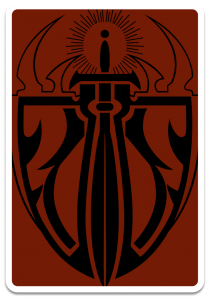 Ok, I said some mean things about the Sinkers in my last post, and DavetheGame came to their defense, so let me step back and unpack that a little bit.
Ok, I said some mean things about the Sinkers in my last post, and DavetheGame came to their defense, so let me step back and unpack that a little bit.
The Sinkers, AKA The Doomguard, are another Planescape faction. They are more or less entropy cultists, feeling that decay and destruction are not only inevitable, but desirable, as it is only through the destruction of all things that we will clear a path to a perfect universe. Or so they say. Mostly, it’s just an excuse to smash things. They are, as you might expect, violent and destructive.
Now, let me step back a bit. One of the interesting things about Planescape is that each faction has a role in the city. Because the ruler of the city (The Lady of Pain) is hands off (unless you piss her off), the factions have stepped into fill most civil roles out of necessity. General consensus is that the Lady of Pain tolerates them because they keep things working, and no one wants to piss of the Lady.
The thing is, the factions are not necessarily nice, but they do their jobs. As I noted previously, the Bleak Cabal are, well, pretty bleak, but they run the poorhouses and charities. The Harmonium serve as police. The Fated (who are jerks) keep the records. The Godsmen keep the forges going. Everyone has a role, even the Revolutionary League, whose role is to take down the other factions! The exception is the Xaositects, but that is part and parcel of the discordian/fishmalk package.
The Doomguard control the city’s armory.
On paper, this makes some sense. They’re arguably the most martial of the factions, so someplace weapony seems appropriate. But there’s a problem – there’s no actual point to having an armory in Sigil. It’s not like all the weapons are kept there, and if they were, what woudl be done with them? There’s no army to equip, and since the only way in or out of sigil is through magical doors (which are controlled by the Lady of Pain) there is no call for a standing army. It’s possible that ancient secret weapons are stored there, but if that is so, then the Doomguard are the worst possible choice to control the Armory.
So, as written, they’re a bunch of violent nutbars with no real role in the setting except to get used as plot devices in published adventures that I’d rather not talk about.
But the idea is salvageable, and here is how I do it.
The doomguard have been given the Armory and tasked with the defense of the city from external threats. When something big and unpleasant shows up and starts inflicting propery damage, the sinkers roll out of the armory gates and go forth to inflict great violence upon it. When the do so, they are allowed to use weapons and spells of great destructive potency, ones that are normally barred from deployment in the city.
This does not happen often – the Sinkers do enough damage on their rampages that the threat needs to be pretty serious, but such threats do exist, and relying on the Lady to deal with every such threat seems like an excellent way to test her patience. By agreement, three other faction heads must agree to unleashing the doomguard, but in the face of an obvious threat, the Doomguard have not always been meticulous in adhering to those rules.
But for all that, they serve a critical purpose in Sigil, not terribly different than that of a fire patrol. This also fuels some rivalry between the Harmonium and the Doomguard, as the former are tasked with keeping the streets safe ona day to day basis. The Harmonium would like nothing better than to be able to arm and equip themselves to deal with these threats, but no other faction is comfortable giving them that kind of power. They find it maddening that these berserkers are trusted off the leash to do work the Harmonium woudl be better suited to handle. This is exacerbated by the fact that the Doomguard explicitly dsescribe themsleves as handling threats no one else is tough enough for, and are entirely willing to rub this in the Hardhead’s faces.
With that change, the doomguard are welcome in my Sigil. They’re still nuts and dangerous, but they serve a purpose. They’re a part of the city, and for me, that’s the most important thing.

